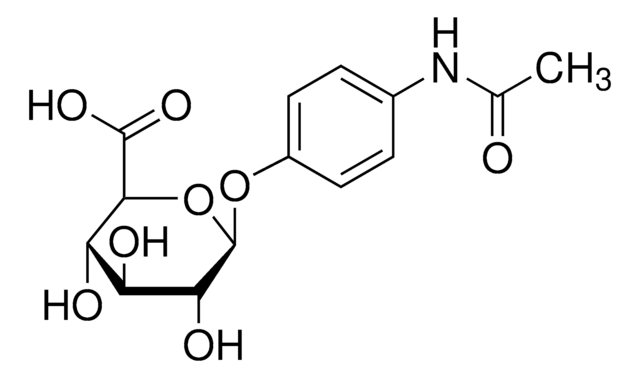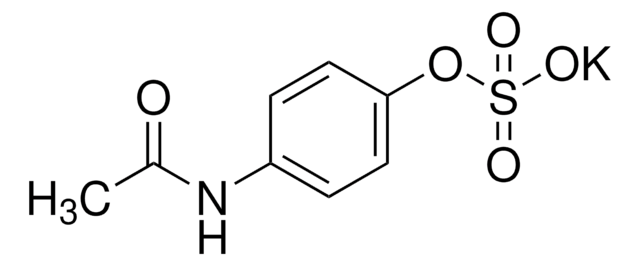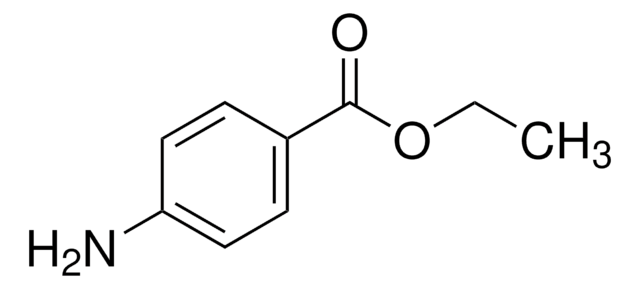Wszystkie zdjęcia(1)
Kluczowe dokumenty
A7300
N-Acetylbenzoquinoneimine
Synonim(y):
N-(4-Oxo-1-cyclohexa-2,5-dienylidene)acetamide, N-Acetyl-p-benzo-quinoneimine, NAPQI
Zaloguj sięWyświetlanie cen organizacyjnych i kontraktowych
About This Item
Wzór empiryczny (zapis Hilla):
C8H7NO2
Numer CAS:
Masa cząsteczkowa:
149.15
Numer MDL:
Kod UNSPSC:
12352100
Identyfikator substancji w PubChem:
NACRES:
NA.22
Polecane produkty
Formularz
solid
Poziom jakości
temp. przechowywania
−70°C
ciąg SMILES
CC(=O)\N=C1\C=CC(=O)C=C1
InChI
1S/C8H7NO2/c1-6(10)9-7-2-4-8(11)5-3-7/h2-5H,1H3
Klucz InChI
URNSECGXFRDEDC-UHFFFAOYSA-N
Szukasz podobnych produktów? Odwiedź Przewodnik dotyczący porównywania produktów
Powiązane kategorie
Zastosowanie
Reactant involved in:
- Redox reactions
- Hydrohalogenation
- pH dependent reactions: in acidic media it is hydrolyzed, hydroxylated in alkaline media, and dimerized at intermediate pHs
- Mediation of acetaminophen hepatotoxicity
- Studies to identify the utility of acetaminophen for treating autoimmune disorders
Inne uwagi
Acetaminophen metabolite that reacts with serum proteins.
Przestroga
air, moisture and light sensitive
Ta strona może zawierać tekst przetłumaczony maszynowo.
Kod klasy składowania
11 - Combustible Solids
Klasa zagrożenia wodnego (WGK)
WGK 3
Temperatura zapłonu (°F)
Not applicable
Temperatura zapłonu (°C)
Not applicable
Środki ochrony indywidualnej
Eyeshields, Gloves, type N95 (US)
Wybierz jedną z najnowszych wersji:
Masz już ten produkt?
Dokumenty związane z niedawno zakupionymi produktami zostały zamieszczone w Bibliotece dokumentów.
Klienci oglądali również te produkty
Angela S Burke et al.
Chemical research in toxicology, 23(7), 1286-1292 (2010-06-29)
Acetaminophen (APAP) toxicity in primary mouse hepatocytes occurs in two phases. The initial phase (0-2 h) occurs with metabolism to N-acetyl-p-benzoquinoneimine which depletes glutathione, and covalently binds to proteins, but little toxicity is observed. Subsequent washing of hepatocytes to remove
Laura P James et al.
Drug metabolism and disposition: the biological fate of chemicals, 37(8), 1779-1784 (2009-05-15)
Acetaminophen (APAP)-induced liver toxicity occurs with formation of APAP-protein adducts. These adducts are formed by hepatic metabolism of APAP to N-acetyl-p-benzoquinone imine, which covalently binds to hepatic proteins as 3-(cystein-S-yl)-APAP adducts. Adducts are released into blood during hepatocyte lysis. We
Amaresh Kumar Sahoo et al.
Nanoscale, 3(10), 4226-4233 (2011-09-08)
Herein, we report the generation of a composite comprised of p-hydroxyacetanilide dimer and Ag nanoparticles (NPs) by reaction of AgNO(3) and p-hydroxyacetanilide. The formation of the composite was established by UV-vis, FTIR and NMR spectroscopy, transmission electron microscopy and X-ray
Hui Ting Chng et al.
Journal of biomolecular screening, 17(7), 974-986 (2012-05-31)
The zebrafish model has been increasingly explored as an alternative model for toxicity screening of pharmaceutical drugs. However, little is understood about the bioactivation of drug to reactive metabolite and phase I and II metabolism of chemical in zebrafish as
Cross-linking of protein molecules by the reactive metabolite of acetaminophen, N-acetyl-p-benzoquinone imine, and related quinoid compounds.
A J Streeter et al.
Advances in experimental medicine and biology, 197, 727-737 (1986-01-01)
Nasz zespół naukowców ma doświadczenie we wszystkich obszarach badań, w tym w naukach przyrodniczych, materiałoznawstwie, syntezie chemicznej, chromatografii, analityce i wielu innych dziedzinach.
Skontaktuj się z zespołem ds. pomocy technicznej







